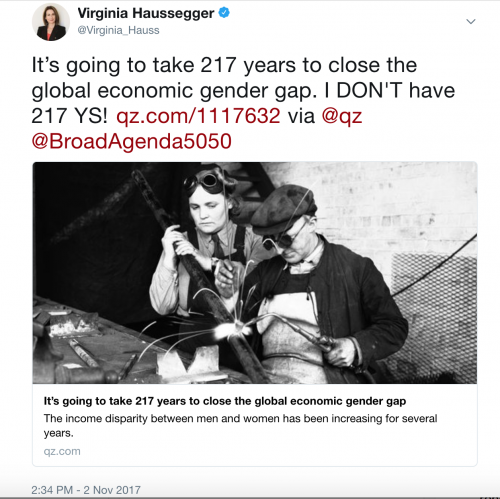We have a target. Actually, we have many. At a meeting of the UN two years ago, Australia was one of 193 countries to agree to 17 Sustainable Development Goals (SDGs) as the backbone of a global development agenda that will be in place until 2030. In contrast to the previous Millennium Development Goals (MDGs), a core feature of the SDGs is their universality – they apply equally to rich developed countries like Australia as to the world’s poorest nations.
SDG 5 focuses specifically on gender equality and empowerment of women and girls. So, in the lead up to 2030, Australia has an opportunity to improve on the obvious measures of gender parity as well as end some of the more insidious forms of everyday sexism, as part of worldwide effort towards creating a future that is more equitable and sustainable. Gender equality is also recognised as central to achieving many of the other goals as well, and has been described as “one of the most powerful and under-leveraged solutions we have for environmental sustainability”.
This is not just a challenge for our governments, but for all citizens
This is not just a challenge for our governments, but for all citizens: for our organisations, industries, communities and even our households. But – and here’s the critical question – can we all genuinely commit to this task? And how creative and ambitious dare we be?

Each of the 17 SDGs is supported by targets that are designed to be ‘specific, measurable, achievable, relevant and time bound’, and indicators that are intended to assist with implementation and monitoring. Goal 5’s targets for women and girls includes ending discrimination, eliminating violence and harmful practices, recognising unpaid work, ensuring full and effective participation in public life, and ensuring access to sexual and reproductive health, among others. Although more specific than the over-arching goal, these targets are nevertheless still somewhat vague. However, this can be an advantage if the stated targets are used as a springboard to force serious and meaningful conversations around the real life experiences of women and girls, and what practical changes they want to see. And, of course, if subsequent action is taken.
So how are we tracking when it comes to gender equality?
We are off to a slow start. The SDGs are not legally binding, and the onus is on countries to devise their own nationally-relevant plans and policies to meet the targets. While some nations began reporting on their efforts from 2016, Australia will not produce its first review until 2018.

Source: 2017 SDG Index for Australia
A first glance the 2017 indicators suggests the overall situation isn’t too bad, with green dots reassuring us that Australia is doing ok. The red flag highlights Australia’s persistent inability to close the gender wage gap, which remains a glaring sore point for Australia. But what about the other targets?
Target 5.2 measures the value of unpaid and domestic work. The latest census data for Australia is not flattering, with women shown to shoulder the bulk of unpaid domestic housework, and consequently facing real and long-term economic disadvantages.
We can – and indeed should – celebrate the green dot next to contraception. But at the same time we can’t ignore the undiscussed fact that abortion is – theoretically at least – still a criminal act in NSW and Queensland, where a Doctor is required to confirm she believes it is necessary in order to avoid serious danger to a woman’s physical or mental health. In other words, in 2017, many Australian women still lack freedom of control over their sexual and reproductive outcomes.
Our 2017 rank in the Global Gender Equality Index for political empowerment also shows that the pipeline has not delivered, with a drop from 32 (out of 144 nations) in 2006 to 48/144 in 2017. We haven’t even managed to crack the critical threshold of 30% of women in national parliaments – let alone the ultimate goal of 50/50 representation of women in public leadership.
What is Australia doing to address this?
The Federal Office for Women is planning to launch an online platform “to support a national conversation on Australia’s collective efforts in implementing Goal 5” – including a call for case studies. This is a good sign. There is strong encouragement from the UN that implementation of SDGs at the national level be inclusive and participatory.
However, facilitating genuinely open dialogue about what SDG 5 means for Australia may be difficult given the ‘development’ context of the UN agenda and the strong tendency to focus our gaze on what improvements need to be made in other countries – especially those countries we consider less developed. That’s not at all to diminish the serious challenges women in developing countries face – but we would be failing if we can’t acknowledge the insidious and deep-rooted gender inequalities that still exist in Australia.

Another potential impediment to making the most of the SDG ‘moment’ in Australia, and grasping the opportunity presented by a global focus, is the danger of falling back on predictable, easily-measureable, initiatives that were being pursued anyway, while failing to acknowledge the prevailing cultural attitudes that continue to hinder Australia’s progress.
SDG 5 provides a powerful pathway. But will we truly embrace what it’s asking us to do
As the 2016 survey by Plan International and Our Watch demonstrates, “for young women and girls to feel and be safe and equal in every aspect of their lives, we must tackle the social norms, structures, attitudes and practices that contribute to gender inequality, if we are to create a future based on gender equality and respect”. Such work needs to be extended to women of all ages, and with attention to differences across and within communities. However, one thing is abundantly clear – we can’t afford to wait and see. We need action. SDG 5 provides a powerful pathway. But will we truly embrace what it’s asking us to do?




